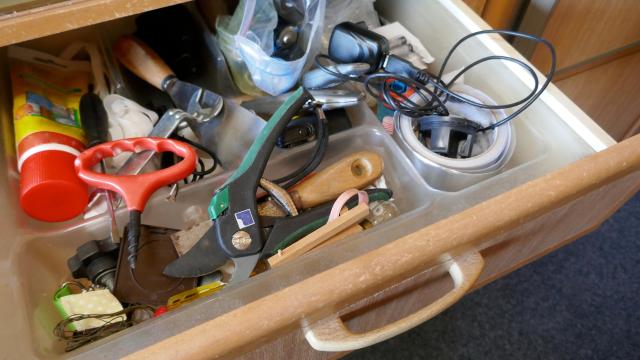Even the most pristinely organised and Marie Kondo’d among us still have a junk drawer — that place where tangled headphones, scrapbooking tape, Costa Rican coins, and one random golf ball coexist simply because we lead busy lives and don’t have time to put everything back in its proper place. But, while a junk drawer is understandable — nay, necessary to functional existence — it should be more than a borderline trash receptacle.
Which means (groan it with me now) cleaning it out periodically. While it’s tempting to make it an unapologetic “get-out-of-organising-free” zone, if left untended, it’ll only become a headache later. Conduct periodic audits to aggregate small items, install dividers, and purge. Because yes, a junk drawer is full of random things, but they should be things you use frequently or need quick access to in case of emergency. Here are some items you can remove today.
Tools: You may want easy access to that screwdriver, but long, sharp objects in the process of rusting should not be kept next to spare chopsticks and condiments packs. The same goes for scissors and batteries in various stages of expiration and corrosion.
Sauce packets: We know, it’s wasteful to just toss them. But do you really need (and will you ever use) 46 packs of ketchup, duck sauce, and mustard? If your eco-conscious heart can’t bear discarding them, considering passing them to a friend who uses them often, depositing them in your work kitchen, or hoarding them in a separate cabinet for later use. No need to waste valuable real estate creating a condiment warehouse in one small drawer.
Takeout menus: There are some who say you no longer need printed takeout menus, with the ubiquity of digital menus online. To which I say, have you ever tried to take a group order involving grandparents? Keep takeout menus you use often, toss the rest. And you don’t need five, even if it’s from your favourite spot. (Remember, you’ll get another one the next time you order, which will probably be next week.)
Old rubber bands and twist-ties: Not all rubber bands and twist ties, just the ones the ones that are dry-rotted, tangled beyond all recognition, old, brown, or fraying. You don’t need those.
Broken items: If you’re looking at a small, random piece of plastic or chipped ceramic thinking, “I know this goes to something,” no it doesn’t. I mean, it did, in a former lifetime, but those days are gone. Stop kidding yourself that you’re going to “get some wood glue and fix it.” Unless you can commit to repairing the item this week, toss broken bits and the larger items they were once attached to.
Random cords: Here’s the deal. If you haven’t used any of those cords for a year (or four), you no longer use the device they once charged, and it’s time for them to take a hike into the nearest trash can. If you must store them on a shelf in your laundry room for another year to be 100% sure you won’t need them, fine. Put a label on the bag with a friendly reminder to “Throw these effers out by X date.”
(Junk) mail: Some would argue that it’s better to tuck the day’s mail away in a drawer than to let it clutter the countertop. I would argue that you may never see that mail again in any readable format. Allow me to share a guideline I wholeheartedly aspire to, but cannot, for the life of me, master: Follow the “touch-it-once” rule for mail and other papers. Open, sort, file, append to the fridge, and throw out everything the first time you touch it, rather than letting it gather and multiply. It’s a good goal. A great goal, even.
Old receipts: Do you need to know how much you spent on those grilled cheese sandwiches your offspring licked, tore apart, poked holes in, and dropped on the floor of the floor of the restaurant? No. Unless you plan on getting a refund, hanging on to gas, Dunkin’, haircut, and restaurant receipts is a losing game.
Coupons: Coupons have the best chance of being used if they are visible; pinned to your refrigerator door, kept in a mail caddy, or inside your wallet. Sending them to the junk drawer is a surefire way not to experience those savings.
Important documents: Whether or not you actually read instruction manuals, it’s a good idea to store them all in one spot, where they can’t get wet, ripped, or crushed by a giant flashlight. The same goes for anything related to your taxes, bills, pay stubs, insurance, investments, or bank accounts.
Souvenirs: Keychains, rubber band bracelets, koozies, magnets, postcards, and the like don’t need to be clog up your junk drawer. (But they’re junk, you say.) Yes, but if you can’t even open the junk drawer, its existence is futile. Unless it’s something you envision using or displaying, toss the chintzy tchotchkes — or at least move them to a “memory box” that lives somewhere besides your kitchen.

Leave a Reply
You must be logged in to post a comment.